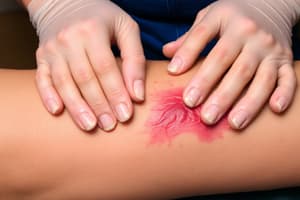Podcast
Questions and Answers
Which term is synonymous with pressure ulcers?
Which term is synonymous with pressure ulcers?
- Bedsores (correct)
- Joint inflammations
- Skin abrasions
- Muscle tears
What is a significant risk factor for pressure injuries in clients who are incontinent?
What is a significant risk factor for pressure injuries in clients who are incontinent?
- Exposure to excessive sunlight
- Moist, bacteria-saturated environment (correct)
- Regular exercise routines
- Low humidity levels
What is a common consequence of lack of nutrition in relation to pressure injuries?
What is a common consequence of lack of nutrition in relation to pressure injuries?
- High serum albumin levels
- Increased muscle mass
- Enhanced sensory perception
- Malnutrition-related skin breakdowns (correct)
What is a significant risk factor for pressure injuries in clients with peripheral neuropathy?
What is a significant risk factor for pressure injuries in clients with peripheral neuropathy?
What is a key risk factor for pressure injuries in clients who are paralyzed or have restricted mobility?
What is a key risk factor for pressure injuries in clients who are paralyzed or have restricted mobility?
Which term is used interchangeably with pressure ulcers?
Which term is used interchangeably with pressure ulcers?
What is a significant risk factor for pressure injuries in clients with peripheral neuropathy?
What is a significant risk factor for pressure injuries in clients with peripheral neuropathy?
What is a significant risk factor for pressure injuries in clients who are incontinent?
What is a significant risk factor for pressure injuries in clients who are incontinent?
What is a key risk factor for pressure injuries in clients who are paralyzed or have restricted mobility?
What is a key risk factor for pressure injuries in clients who are paralyzed or have restricted mobility?
What is a common consequence of lack of nutrition in relation to pressure injuries?
What is a common consequence of lack of nutrition in relation to pressure injuries?
Flashcards are hidden until you start studying
Study Notes
Pressure Injuries and Their Risk Factors
- Pressure ulcers are also referred to as pressure injuries, and synonymous terms include bedsores and decubitus ulcers.
- Incontinence significantly increases the risk of developing pressure injuries due to skin moisture leading to maceration and breakdown.
- A common consequence of poor nutrition is delayed wound healing, which can exacerbate the severity of pressure injuries.
- Peripheral neuropathy increases the risk for pressure injuries as it can result in a lack of sensation, leading to injuries going unnoticed.
- Paralyzed clients or those with restricted mobility are at high risk for pressure injuries due to prolonged pressure on bony prominences without movement.
Summary of Key Risk Factors
- Incontinent individuals are more susceptible to pressure injuries due to compromised skin integrity.
- Peripheral neuropathy can prevent individuals from recognizing pressure or discomfort, heightening the risk of skin breakdown.
- Restricted mobility or paralysis prevents individuals from repositioning, increasing the risk of pressure injuries in areas with continuous pressure.
- Poor nutrition can impede the body's ability to repair skin, making it a significant factor in the development and healing of pressure injuries.
Studying That Suits You
Use AI to generate personalized quizzes and flashcards to suit your learning preferences.





